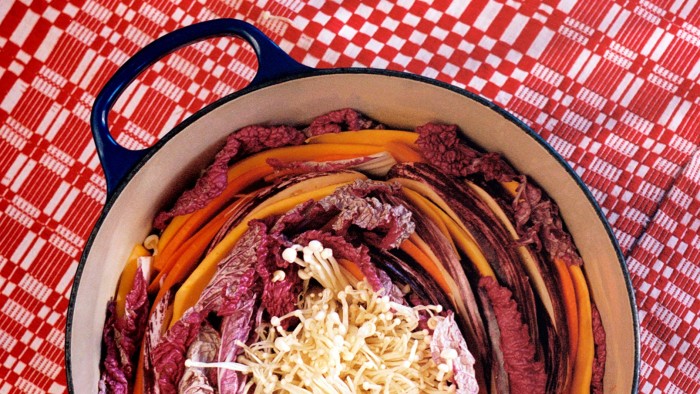Unlock the Editor’s Digest for free
Roula Khalaf, Editor of the FT, selects her favourite stories in this weekly newsletter.
Cooking for someone is the most immediate transfer of emotions that I can think of. When you listen to a piece of music or look at a painting, it may touch you on different levels, but the immediacy with which it happens with food is unmatched. I believe it’s impossible to smell a pot of bolognese bubbling on the stovetop and feel absolutely nothing. The emotions conjured by something as simple as an onion sautéing with bay leaf can be quite extraordinary. If a loved one is feeling joy or sadness, sorrow or satisfaction, my first response is to cook for them. We cook to celebrate success, just as we do for those mourning a loss or welcoming a new life.

In the face of heartbreak, I do what I’ve always done, which is turn towards my stove. And lately, my heart has been breaking for what seems like a broken world. As this column chronicles, I believe in throwing celebrations based on imaginary holidays. I also believe that coming together with people you love is especially imperative. As an immigrant in America, I feel the need to come together with other immigrants to create a space to see and hear each other, and process everything going on.
And so, cooking for my most recent gathering, I wanted to create a dish that felt gentle. There is a type of cooking that feels powerful and intense, like grilling or frying a big piece of meat on an open fire, and then there is another type of cooking that feels softer and calming, like slowly braising a stew, poaching a piece of delicate fish or steaming a big pot of vegetables. I was craving something calming, both in the cooking process and the dish itself, so I came up with a dish I am calling Veggies in a Blanket.


The recipe takes inspiration from Japanese mille-feuille nabe, which is traditionally made of napa cabbage and sliced pork belly cooked in soy sauce and dashi. I made two versions, one that contained meat and the other for my vegetarian friends. For the latter, I decided to add thin but long slices of squash, carrot, aubergine and courgettes. I was lucky to come across napa cabbage, which has the most beautiful purple tone and therefore turned the stew an almost fictitious colour that impressed my toddler and my guests alike. For the version that contained meat, I layered very thinly sliced pieces of pork shoulder among the vegetables. In lieu of the traditional Japanese flavourings, I opted for vegetable stock for the vegetarian pot and chicken for the one containing meat.
It is fairly simple to produce your own version of Veggies in a Blanket. Instead of a conventional recipe, it is best to think about what vegetables you may have on hand (or what you can source at this time of the year). I recommend including cabbage, as it bulks up the dish and binds everything together. Once you’ve got the vegetables, you start off by cutting them in fairly uniform, long thin pieces, which you layer inside a Dutch oven (or another large, heavy-bottomed pot): the idea is to create a sort of vegetable spiral motif. In the middle, I placed a handful of enoki and chestnut mushrooms. If you are using meat, it must also be sliced very thinly and layered between the pieces of vegetable.



Once all the vegetables were blanketed, I added a bit of salt and then poured the hot stock halfway up the dish, covered and gently simmered until everything was cooked, which took about 30 minutes. I served both versions of the dish in the pot they were cooked in. The vegetables steamed and created a flavourful soup around them, which we had with rice.
I consider this loose recipe to be one with high-production value, as they say. It takes minimal effort, but the end result is as visually impressive as it is delicious. We enjoyed the stews with a couple of bottles of slightly chilled white Burgundy, which were rich and creamy, and rounded off an evening of contemplation, comfort and calm. Over the course of the night, I felt as though the warmth of the stove I had turned to was channelled through me, via the dish, and onto my friends. And that is the magic of cooking for people you love.

